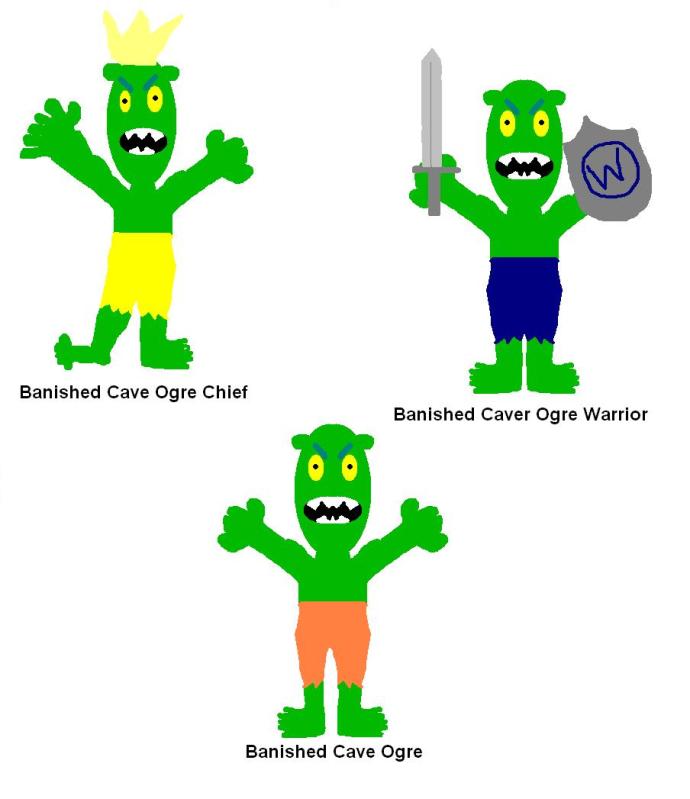|
Ogres
Ogres are large, greenish humanoids. They are generally larger and stronger than the
average human. They live at a moderate level of interaction, living in village or tribal groups. They are
omnivores eating both meat and vegetable matter.
There are two distinct populations of Ogres in Valorn. One is strongly matrilineal; the other appears comprised
of individuals who left female-dominated society. They appear to have a form of written communication (and not
merely scribbles) as there is at least one human who appears able to translate it.
Forest Ogres
The Ogres in the forest north of Dundee build shelters, although not of the strongest construction, perhaps
indicating little need to have protection from the elements. Their other structures are built more sturdily
showing they do have the skill when required.
The Forest Ogres also possess the ability to work metal. Their chainmail and full platemail are strongly
constructed, if of poor appearance, and they bear an offensive odor. It has been suggested that lavender or
thorough airing out in the magma fissure may reduce the stench.
They show a tactical sense, building their village in such a way it is difficult to move troops towards their
temple. The fact that the village still stands, despite numerous attacks by Adventurous, also indicate their
stubborn, territorial nature. The tunnels they make are of stone, mortared together, again showing a level of
skill not indicated by the haphazard village below. This could also indicate the relatively low status of the
ogre villagers.
Their temple is the most solidly build structure in the village and filled with statues and icons to
unidentifiable deities. It has so far been impossible to have a conversation with an ogre about the temple.
Even the lone ogre merchant doesn’t converse as much as point at items and give coin for them.
The higher ranked ogres dwell in the temple complex as well. As the only ones observed there have been female,
although males guard the outer tunnels, this again is a reflections of the matrilineal nature of this population.
Indeed, caste appears a strong influence on the Ogre life. The weaker ogres dwell on the fringes of the village
with the stronger ones dwelling with in it.
When discussing the Ogres who dwell in the forest, it is necessary to bring up a distasteful subject – their
diet. Among the other creatures that make u their diet, the forest Ogre eats humans as well. The temple
kitchen area is well appointed for dealing with carcasses of that size. Recent excursions into the forest may
be an indication they are attempting to resupply.
Cave Ogres
The second known population of Ogres is between Fartown and Branishor. This group dwells in a cave complex that
appears only roughly shaped by them. While there is none of the building ingenuity evidence by the forest Ogres
and indeed brute force seemed used in making the tunnels, there is rudimentary farming. The Cave Ogres appear
to raise fungi in well manured, warm caves. Basic equipment such as rakes has been reported. Remains of
Adventurous have been found, but not in an area resembling a kitchen. Instead the bodies were piled and
apparently left to rot and decay. From this the deduction can be made that the Cave Ogres do not eat humans as a
normal part of their diet, if at all.
From a search of the complex, a large number of nonhuman (and nonogre) bodies have been found. From the eyeless
state it appears as if this cave complex may have been inhabited before the Ogres came to claim it as their own.
The Cave Ogres appear more homogenous in makeup than the Forest Ogres, perhaps further support for the theory
that they are a breakaway group that felt unduly strained by the matrilineal social structure. If that is the
case, it is logic to suppose that those at the top of their allowed place in the hierarchy would be the most
resentful and most likely to leave.
While the Cave Ogres have an altar of some sort, it cannot be ascertained what exactly they may worship.
The number of clean bones used structurally about the altar can lead the more theologically minded to their own
conclusions.
 Topaz the Poet Topaz the Poet
There once was a warrior named Raffe.
From ogres he seldom was safe.
He went to their village
to flirt, not to pillage,
with each ogre lady or waif.


by Asrai
|
|
 Topaz the Poet
Topaz the Poet

